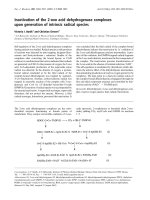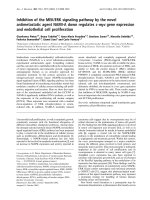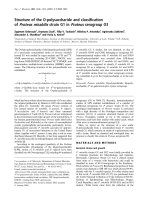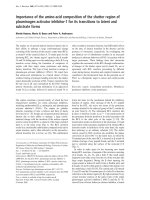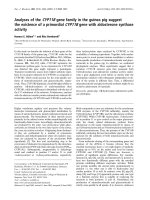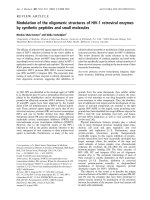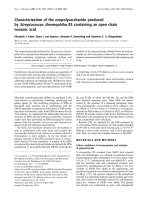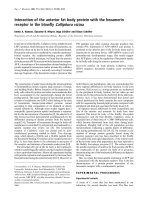Báo cáo y học: "Validity of the 32-item Hypomania Checklist (HCL-32) in a clinical sample with mood disorders in China" pps
Bạn đang xem bản rút gọn của tài liệu. Xem và tải ngay bản đầy đủ của tài liệu tại đây (271.95 KB, 7 trang )
RESEARCH ARTICLE Open Access
Validity of the 32-item Hypomania Checklist
(HCL-32) in a clinical sample with mood disorders
in China
Hai-chen Yang
1,2†
, Cheng-mei Yuan
3†
, Tie-bang Liu
2†
, Ling-jiang Li
1*
, Hong-jun Peng
1
, Chun-ping Liao
2
,
Han Rong
2
, Yi-ru Fang
3
and Jules Angst
4
Abstract
Background: The 32-item Hypomania Checklist (HCL-32), a questionnaire for screening bipolar disorders, has been
utilised in several countries, but it unclear if the Chinese version of the HCL-32 is valid.
Methods: Consecutive patients with bipolar disorders (BP, N = 300) and unipolar major depression (UP, N = 156)
completed the Chinese version of the HCL-32. The subjects underwent a structured clinical interview for DSM-IV
Axis-I disorders (SCID).
Results: The eigenvalues for the first three factors in the HCL-32 were calculated as 5.16 (active/elated), 2.72 (risk-
taking) and 2.48 (irritable) using factor analysis. Cronbach’s alpha for the HCL-32 was calculated to be 0.88. Positive
responses to twenty-eight items were significantly more frequent by patients with BP than those with UP, and the
other four items (7th, 21st, 25th and 32nd) showed no such trend. Fourteen was the optimal cut-off for
discriminating between BP and UP. The HCL-32 distinguished between BP-II and UP, with 13 being the optimal
cut-off. A cut-off of 13 yielded a sensitivity of 0.77 and a specificity of 0.62 between BP and UP.
Conclusions: This study demonstrated that the simplified Chinese version of HCL-32 was valid for patients with
mood disorders. The optimal cut-off of 13 for distinguishing between BP-II and UP was valid and could be used to
improve the sensitivity of screening BP-II patients when the HCL-32 is used in psychiatric settings in China.
Background
It is important to differentiate bipolar disorders (BP)
from other mood disorders; delayed diagnosis or misdiag-
nosis can prolong the suffering of patients [1-3] but accu-
rate early diagnosis can be difficult [3,4]. As many as 40%
of patients with bipolar disorders are initially misdiag-
nosed, and it can take as long as 10 years before these
patients are diagnosed correctly [4]. In the general popu-
lation, the misdiagnosis rate can be as high as 69% [5]. In
China, 45.4% of outpatients with bipolar disorders are
diagnosed incorrectly [6]. Bipolar patients often present
in the depressive phase [7] and many patients with BP
(particularly bipolar II) are diagnosed as having unipolar
depressive disorder [3-8]. Clinical guidelines published by
the America n Psychiatric Ass ociation indicate that bipo-
lar II disorder (BP-II) is often initially misdiagnosed as a
major depressive disorder, leading to patients receiving
incorrect treatments [9]. Hypomania, an element of bipo-
lar II disorder, is not usually perceived by patients to be
pathological and is not reported to clinicians [10,11]. The
retrospective detectio n of hypomania is crucial for a cor-
rect diagnosis of bipol ar disorder, particularly for BP-II.
An instrument to d etect hypomania retrospectively
would be useful in clinical settings.
Recent studies have demonstrated that the 32-item
Hypomania Checklist (HCL-32) developed by Jules
Angst is a good screening instrument for past hypoma-
nic episodes [12-15]. The HCL-32 is a self-administered
questionnaire that screens for a history of hypomanic
symptoms using thirty-two yes/no items and takes into
account the subject’s current mental state. The HCL-32
was demonstrated to have good sensitivity (0.80) and
* Correspondence:
† Contributed equally
1
Mental Health Institute, the 2nd Xiangya Hospital, Central South University,
No. 139 Renmin Zhong Road, Changsha 410011, China
Full list of author information is available at the end of the article
Yang et al. BMC Psychiatry 2011, 11:84
/>© 2011 Yang et al; licensee BioMed Central Ltd. This is an Open Access article distributed under the terms of the Creative Commons
Attribution License ( which permits u nrestricted use, distribution, and reproduction in
any medium, provided the original work is properly cited.
specificity (0.51) at an optimal cut-off of 14, in a sample
comprising predominantly outpatients with BP and UP
in Europe [12]. The HCL-32 can distinguish between BP
and UP at a cut-off of 14 (sensitivity 0.82 and specificity
0.67) in Taiwan [14]. However, little is known about the
usefulness of HCL-32 for patients with mood disorders
in China. In China, simplified Chinese characters are
used, whereas in Taiwan complicated Chinese characters
are used. Furthermore, in Taiwan different terms are
used to express anxiety and emotion in patien ts. There-
fore, the Taiwanese version of th e HCL-32 is difficult to
use in mainland China.
The aim of this study was to evaluate the feasibility of
using a simplified Chinese version of the HCL-32, to
examine its psychometric properties and accuracy as a
screening tool for bipolar disorders. The results were
compared with those from previous studies concerning
the use of the HCL-32 in various countries.
Methods
Subjects
Subjects from the outpatient and inpatient departments at
Shenzhen and Shanghai mental health ce ntres were
enrolled in the study from January 2006 to December
2008. The Shenzhen Mental Health Centre is the only psy-
chiatric hospital in Shenzhen city. The study was approved
by the ethics committees of the two psychiatric hospitals.
Patients who satisfied the inclusion and exclusion cri-
teria were evaluated. The inclusion crite ria comprised
patients diagnosed with major depressive disorder (unipo-
lar depressive disorder, UP), bipolar I disorder (BP-I) or
bipolar II disorder (BP-II), aged between 18 and 60 years,
educ ated for a minimum of five years, an d who pro vided
written informed consent. The exclusion criteria com-
prised patients diagnosed with an unstable or severe clini-
cal st atus, those who could not coo perat e with the study
procedures, patients who had received electroconvulsive
therapy (ECT) or modified electroconvulsive therapy
(MECT) during the previous four weeks, individuals who
were illiterate, suffering from mental retardation, dementia
or intellectual impairment. Subjects did not have to have a
certain clinical status as the aim was to elucidate the rela-
tionship between current state and HCL-32 scores.
Measure
Upon consent from the author of the original HCL-32
(Jules Angst), the English version of the HCL-32 was
translated i nto a simplifi ed Chinese version. Back trans-
lation was performed by a bilingual psychiatrist una ware
of the original HCL-32. A preliminary translated version
was administered to individuals without psychiatric ill-
ness and patients with mooddisorders.Theauthors
reviewed the results of this preliminary investigation
before producing the final version.
The contents of the HCL-32 were explained to the
subjects and it was completed before the Structured
Clinical Interview for DSM-IV Axis-I Disorders (SCID)
was carried out; interviewers were blind to the HCL-32
results. All interviewers were psychiatrists with a mini-
mum of five years experience. The kappa coefficient for
diagnosis of bipolar disorders was 0.83.
There were contents concerning rating of current
mental states (much worse than usual, worse than usual,
a little worse than usual, neither better nor worse than
usu al, a li ttle better than usual, better than usual, much
better than usual) in the HCL-32 in addition to the 32
items [12]. Subjects were asked to select one certain
state.
Statistical Analyses
Principal component analysis with varimax rotation was
used to determine the construct validity of the HCL-32.
Eigenvalues > 1 were initially retained and clinical con-
siderations decided the final number of factors. The
internal consistency of the HCL-32 was determined
using Cronbach’s alpha. Spearman correlation analysis
was performed on the current mental state and the total
score. Current mental states and the mean total HCL-32
scores were compared between groups using the Krus-
kal-Wallis test. The frequency of each symptom item
and the total HCL-32 score were compared between
groups using a t-test. The receiver operating characteris-
tic (ROC) curve was used to distinguish between groups
and to ascertain the sensitivity and specificity at various
cut-offs. ROC curves can be difficult to understand.
Therefore, the change in sensitivity and specificity at
various cut-offs are presented in figures, rather than the
ROC curve. Positive predictive value was defined as the
proportion of subjects screened as positive for BP using
the HCL-32 and having DSM-IV BP. Negative predictive
value was defined as the proportion of subjects screened
as negative for BP using the HCL-32 who had DSM-IV
UP. Probability values less than 0.05 were considered
statistically significant. All statistical analyses were car-
ried out using SPSS-15.0 for Windows (SPSS, Chicago,
IL, USA).
Results
Description of samples
Four hundred and fifty six subjects (232 from Shenzhen
and 224 from Shanghai), including 1 97 outpatients and
269 inpatients, were enrolled in the study (Table 1). The
mean age of BP patients was significantly lower than
that of UP patients (t = 5.24, P < 0.01).
Frequency of positive responses
The frequency of positive responses to twenty-eight
items in BP patients was significantl y higher than in UP
Yang et al. BMC Psychiatry 2011, 11:84
/>Page 2 of 7
patients, with the exception of four items (7th item,
tend to drive faster; 21st item, more easily distracted;
25th item, more impatient/irritable; 32nd item, take
more drugs; Figure 1).
Current mental state and HCL-32 self-assessment
Mean HCL-32 scores were statistically different between
groups, defined according to the current mental state of
BP and UP (Table 2).
A significant (P = 0.02 ) but low positive correlation (r
= 0.13) was demonstrated between current mental state
and the HCL-32 score in BP patients (N =300)using
Spearman correlation analysis. Simil ar results were
obtained for UP patients (r = 0.23, P < 0.01, N = 156).
Factor analysis
Analysis of data concerning subjects wi th mood disor-
ders (N = 456) using principal component analysis with
varimax rotation, revealed that the eigenvalues of seven
factors were greater than 1, and this explained 51.04%
of the total variance. The eigenvalues of factors I, II, and
III were 5.16, 2.72, an d 2.48, respectiv ely (other facto rs
had eigenvalues < 2). The first three factors together
explained 38.34% of the total variance (Table 3). If all
items suppressed absolute factor loading less than 0.35,
factor I c omprised 13 items (2nd, 3rd, 5th, 10th, 11th,
12th, 13th, 15th, 18th, 19th, 20th, 24th and 28th item),
factor II comprised 7 items (7th, 8th, 9th, 17th, 23rd,
30th and 31st item), and factor III comprised four items
(21st, 25th, 26th and 27th item). Factor I could be
described as “active/elated”, factor II as “risk-taking” and
factor III as “ irritable” . Other factors for which the
eigenvalues were greater than one comprised few items
and were difficult to describe for each factor.
Internal consistency
Internal consistency (Cronbach’salpha)oftheChinese
version of the HCL-32 was 0.88 in patients with mood
disorders (N =456).Cronbach’s alpha of factor I, factor
II and factor III were 0.88, 0.68 and 0.74, respectively.
HCL-32 score comparison between groups
Mean HCL-32 scores of patients suffering with BP, BP-I
or BP-II were statistically higher than those suffering
with UP. There was no sign ificant differenc e in the mean
HCL-32 scores of BP-I and BP-II patients (Table 4).
ROC curve analysis
ROC curve analysis between BP and UP
ROC curve analysis revealed that the HCL-32 could dif-
ferentiate between BP and UP (P < 0 .01), and the area
under the curve was 0.73. A screening score of fourteen
was the optimal cut-off (sensitivity 0.74, specificity 0.66)
between BP and UP. A score of thirteen yielded a sensi-
tivity of 0.77 and a specificity of 0.62. The sensitivity
Table 1 Description of samples
UP BP BP-I BP-II
N 156 300 224 76
% Female 64.10 47.33 50.45 38.16
Age (mean ±
SD)
40.34 ±
14.23
33.76 ±
11.69
33.78 ±
10.67
33.15 ±
14.04
Education in
years
10.21 ±
2.78
11.61 ±
3.40
11.23 ±
3.45
12.48 ±
3.11
Married, % 71.15 65.33 62.50 72.37
LWHP
LWHP
LWHP
LWHP
LWHP
LWHP
LWHP
LWHP
LWHP
LWHP
LWHP
%3
83
Figure 1 Frequency of positive responses between BP and UP patients. In BP patients, the frequency of positive responses to the thirty two
items ranged from 11.6% (7th item, tend to drive faster) to 89.7% (3rd item, more self-confident). In UP patients, the frequency ranged from 6.4%
(29th item, drink more coffee; 31th item, drink more alcohol) to 62.2% (3rd item).
Table 2 HCL-32 scores (mean ± SD) for different levels of
current mood state
Current mental state BP patients UP patients
N HCL-32
score
N HCL-32
score
Much worse than usual 23 13.78 ± 6.20 18 10.56 ± 6.49
Worse than usual 35 16.41 ± 5.62 31 8.97 ± 7.60
A little worse than usual 38 16.78 ± 4.99 28 10.70 ± 5.03
Neither better nor worse than
usual
81 15.16 ± 7.12 46 10.35 ± 6.32
A little better than usual 37 18.19 ± 6.11 19 14.68 ± 6.28
Better than usual 44 16.59 ± 4.91 5 11.00 ± 2.65
Much better than usual 42 18.67 ± 6.45 9 15.56 ± 3.94
Significance (Kruskal-Wallis test) - 0.04 - 0.01
Yang et al. BMC Psychiatry 2011, 11:84
/>Page 3 of 7
and specificity at various cut-offs between BP and UP
are demonstrated in Figure 2.
ROC curve analysis between BP-I and UP
ROC curve analysis demonstrated that the HCL-32
coul d differentiate betwee n BP-I and UP (P <0.01),and
the area under the curve was 0.74. Fourteen was the
optimal cut-of f between BP-I and UP. The sensitivity
and specificity at various cut-offs between BP-I and UP
are presented in Figure 3.
ROC curve analysis between BP-I and BP-II
The HCL-32 could not distinguish between BP-I and
BP-II (P = 0.08) using ROC curve analysis. The area
under the curve was 0.57.
ROC curve analysis between BP-II and UP
ROC curve analysis revealed that the HCL-32 co uld dis-
criminate between BP-II and UP (P < 0.01), and the
area under the curve was 0.69. Thirteen was the optimal
cut -off to discri minate between BP-II and UP. The sen-
sitivity and specificity at various cut-offs between BP-II
and UP are presented in Figure 4.
Positive Predictive Value (PPV) and Negative Predictive
Value (NPV)
At a cut-off of thirteen between BP and UP, the PPV
was 77% and the N PV was 56%. At a cut-o ff of fourteen
between BP and UP, the PPV was 78% and NPV was
54%.
Discussion
Bipolar disorder is very common and the lifetime preva-
lence of bipolar disorder spectrum is approximately
4.5% in the general population [16,17]. Moreover, bipo-
lar disorder is associated with substantial impairments
in productive and social roles [18,19]. The HCL-32 is a
convenient instrument for screen ing bipolar d isorders,
and psychiatrists in several countries use it in practice
[12-15,20,21]. China is the most populated country in
the world. Therefore, a study concerning the use of the
HCL-32 in China is important.
The mean age of BP patients was significantly lower
than that of UP patients in this study, and this is com-
parable with samples used for similar studies [12,14,20].
The percentage of female UP patients was higher than
the percentage of female BP patients. This could reflect
the fact that rates of major depression are higher in
females than in males, and they are comparable for
bipolar disorder [22]. Differences concerning the mean
age and sex ratio between BP and UP patients could
have resulted from enrolling individuals consecutively.
ThereweremoreBP-IpatientsthanBP-IIpatientsas
inpatients as well as outpatients were enrolled in the
study (more inpatients suffer from BP-I than BP-II).
The mean HCL-32 scores were statistically different
between groups, defined according to their current men-
tal state in BP and UP. Therefore, there was a possible
Table 3 Factor loadings of the HCL-32 using factor
analysis (N = 456)
HCL-32 items Active/elated
factor
loadings
Risk-taking
factor
loadings
Irritable
factor
loadings
1. need less sleep 0.32 0.17 0.2
2. more energetic 0.65* -0.02 -0.04
3. more self-confident 0.61* -0.08 -0.08
4. enjoy my work more 0.30 -0.11 0.02
5. more sociable 0.37* 0.03 -0.04
6. want to travel more 0.06 0.16 0.05
7. drive faster 0.06 0.50* 0.02
8. spend more 0.17 0.63* 0.07
9. take more risks 0.09 0.59* 0.10
10. physically more active 0.49* 0.08 -0.09
11. plan more activities 0.64* -0.04 0.02
12. have more ideas/creative 0.64* 0.28 -0.04
13. less shy 0.47* 0.36* -0.02
14. wear more extravagant
clothes/make-up
0.27 0.29 0.13
15. meet more people 0.37* 0.10 0.09
16. more interested in sex 0.16 0.31 0.11
17. more flirtatious 0.19 0.36* 0.10
18. talk more 0.62* 0.12 0.27
19. think faster 0.79* 0.13 0.05
20. make more jokes 0.54* 0.26 0.04
21. more easily distracted -0.16 0.39* 0.53*
22. engage in more new
things
0.24 0.31 -0.06
23. thoughts jump 0.36* 0.52* 0.29
24. do more quickly/easily 0.66* 0.18 -0.11
25. more impatient/irritable -0.01 0.05 0.83*
26. can be exhausting or
irritating
-0.03 0.09 0.80*
27. get into more quarrels 0.07 0.24 0.64*
28. mood higher, more
optimistic
0.67* 0.16 -0.07
29. drink more coffee 0.03 0.12 0.08
30. smoke more cigarettes 0.02 0.43* 0.14
31. drink more alcohol 0.06 0.37* 0.12
32. take more drugs -0.21 0.17 0.32
Eigenvalue 5.16 2.72 2.48
Total variance explained 18.12 8.50 7.75
*:loading ≥ 0.35
Table 4 HCL-32 score comparison between groups
Groups Mean HCL-32 score tP
BP vs. UP 16.51 ± 6.22 vs. 10.90 ± 6.43 9.05 P < 0.01
BP-I vs. UP 16.91 ± 6.35 vs. 10.90 ± 6.43 8.98 P < 0.01
BP-I vs. BP-II 16.91 ± 6.35 vs. 15.15 ± 5.92 1.88 P > 0.05
BP-II vs. UP 15.15 ± 5.92 vs. 10.90 ± 6.43 4.82 P < 0.01
Yang et al. BMC Psychiatry 2011, 11:84
/>Page 4 of 7
impact of current mental state on HCL-32 scores of
patients with mood disorders . This result is similar to
that of a Taiwanese study [14], but different from results
obtained in Europe [12,15]. Low correlation coefficients
were evident between current mental state and the
HCL-32 scor e in BP (r = 0.13) and UP (r =0.23)
patients. The impact of current mental state on the
HCL-32 score is likely to be low and limited.
A three-factor solution using factor analysis in this
study is different from the results obtained in the Eur-
opean and Taiwanese studies [12,14]. Angst reported
two factors ("active/elated” and “ri sk-taking/irritable” )
from the study carried out in Europe [12]. Item 9 (take
more risks) is included in factor II in the European
study, but not in factor I or factor II in the Taiwanese
study [14]. C ombining the factor II and factor III items
in the present study is similar to those of factor II in
the European study. The items of factor II in the Taiwa-
nese study are similar to those of factor III in this study
[14].
Cronbach’s alpha for the HCL-32 was 0.88 in the pre-
sent study. This is comparable to the results from other
studies (0.82 i n Italian sample, 0.86 in Swedish sample,
0.90 in Spanish sample and 0.88 in Taiwanese sample)
[12-15]. The internal consistency of the HCL-32 was
good for various ethnic samples.
The frequency of positive responses to four items (7th,
drive faster; 21st, more eas ily distracted; 25th, more
impatient/irritable; 32nd, take more drugs) in BP
patients was not s ignificantly higher than for UP suf-
ferers. The percentage of people who own a car in
China is low, and this could explain why the frequency
of the 7th item (drive faster) was low in BP (11.6%) and
UP (10.3%) patients. The reason for no significant differ-
ence for the three other items is unclear.
The HCL-32 could distinguish between BP and U P,
BP-I and UP, BP-II and UP, but not between BP-I and
BP-II in the present study. These resul ts are comparable
to those of the European study [12]. However, HCL-32
can distinguish between BP-I and BP-II, w ith the opti-
mal cut-off of 21, in the Taiw an study [14]. Subjects in
the present study and that carried out in Taiwan were
Chinese. In the European and Taiwanese studies, the
duration criterion for hypomania was two days but in
thepresentstudyitwasaminimumoffourdays.The
ratio o f BP-I and BP-II patients between the Taiwanese
study and the European study are similar (66/94 vs.
105/164).
0
0.1
0.2
0.3
0.4
0.5
0.6
0.7
0.8
0.9
1
Scores of HCL-32
VHQVLWLYLW\
VSHFLILFLW\
Figure 2 Sensitivity and specificity at various cut-offs between BP and UP.
0
0.1
0.2
0.3
0.4
0.5
0.6
0.7
0.8
0.9
1
6FRUHVRI+&/
VHQVLWLYLW\
VSHFLILFLW\
Figure 3 Sensitivity and specificity at various cut-offs between BP-I and UP.
Yang et al. BMC Psychiatry 2011, 11:84
/>Page 5 of 7
In this study, fourteen was chosen as the optimal cut-off
between BP and UP if BP was not divided into BP-I and
BP-II. This was s imilar to the results from other studies
[12,14]. In this study, the HCL-32 could discriminate
between BP-I and UP, with the best cut-off being fourteen.
In a UK study, the HCL-32 could distinguish between BP-I
and UP, with the best cut-off being twenty [21].
The HCL-32 could discriminate between BP-II and
UP, with the optimal cut-off of thirteen. The difficulty
in distinguishing between BP and UP is related to diffi-
culties in d iscriminating between BP-II and UP in psy-
chiatric settings. Patients with BP-I are less likely to be
misdiagnosed than those with BP-II. The results from
thecurrentstudysuggestthattheoptimalcut-off
between BP-II and UP should be used, particularly when
considering the continuum of mood disorders. BP-II is
closer to UP than BP-I [23]. The sensiti vity of detecting
BP-II could be improved if thirteen is used as the opti-
mal cut-off between BP and UP. There were more BP-II
patients than BP-I patients [16,17,24-26]. High sensitiv-
ity is imp ortant for a screening instrument (cut-off thir-
teen, sensitivity 0.77, specificity 0.62; cut-off fourteen,
sensitivity 0.74, specificity 0.66). From a clinical perspec-
tive, a screening questionnaire must have g ood sensitiv-
ity even i f that increases false positives because of lower
specificity [27].
The PPV at a cut-off of thirteen was 1% lower than
that at a cut-off of fourteen, while the NPV was higher
than 2%. The PPV and NPV at the cut-off of thirteen
were better than at a cut-off of 14 but the advantage
was not great.
There were limitations in the present study. The num-
ber of BP-I patients was greater th an the number of BP-
II patients, and there were differences in terms of the
mean age and sex ratio between BP an d UP patients.
The duration of the mood disorders were not evaluated
in the current study as diagnoses were correlated to the
duration of mood disorders.
Conclusions
The psychometric properties of the simpli fied Chinese
version of the HCL-32 were demonstrated to be satisfac-
tory using a clinical sample in China. The best cut-off
between BP-II and UP should be regarded as the opti-
malcut-offbetweenBPandUPwhenusingtheHCL-
32. Furthermore, 13 can be used as the optimal screen-
ing cut-off between BP and UP in psychiatric settings in
China.
Acknowledgements and Funding
We thank Dr. Alex Gamma (Zurich University Psychiatric Hospital,
Switzerland) for his suggestions concerning the manuscript. This study was
supported by a grant from the National Natural Science Foundation of
China (30830046 to Ling-jiang Li), the National Science and Technology
Program of China (2007BAI17B02 to Ling-jiang Li), the National 973 Program
of China (2009CB918303 to Ling-jiang Li), Program of Chinese Ministry of
Education (20090162110011 to Ling-jiang Li) and grant (200602032 to Hai-
chen Yang) from the scientific and technological bureau of Shenzhen city.
Author details
1
Mental Health Institute, the 2nd Xiangya Hospital, Central South University,
No. 139 Renmin Zhong Road, Changsha 410011, China.
2
Division of Mood
Disorders, Shenzhen Mental Health Centre, Shenzhen 518020, China.
3
Division of Mood Disorders, Shanghai Mental Health Centre, Shanghai
Jiaotong University School of Medicine, Shanghai 200030, China.
4
Zurich
University Psychiatric Hospital, Switzerland.
Authors’ contributions
Authors LL and HY designed the study and developed the protocols. LL is
the tutor of HY. Authors LL, HY, TL and CY carried out literature searches
and analyses. Authors LL, HY, TL, HP, CL and RH undertook the statistical
analysis and prepared the first draft of the manuscript. All author s were
interviewers. Authors HY and TL oversaw the research in Shenzhen. Authors
CY and YF directed the research in Shanghai. All authors read and approved
the final manuscript.
Authors’ information
1
Mental Health Institute, the 2nd Xiangya Hospital, Central South University,
No. 139 Renmin Zhong Road, Changsha 410011, PR China.
2
Division of
0
0.1
0.2
0.3
0.4
0.5
0.6
0.7
0.8
0.9
1
6FRUHVRI+&/
VHQVLWLYLW\
VSHFLILFLW\
Figure 4 Sensitivity and specificity at various cut-offs between BP-II and UP. A cut-off of thirteen had sensitivity of 0.73 and a specificity of
0.62 between BP-II and UP. A cut-off of fourteen had a sensitivity 0.67 and a specificity 0.66 between BP-II and UP.
Yang et al. BMC Psychiatry 2011, 11:84
/>Page 6 of 7
Mood Disorders, Shenzhen Mental health centre, Shenzhen 518020, PR
China.
3
Division of Mood Disorders, Shanghai Mental Health Centre,
Shanghai Jiaotong University School of Medicine, Shanghai 200030, PR
China.
4
Zurich University Psychiatric Hospital, Switzerland.
Competing interests
The authors declare that they have no competing interests.
Received: 21 November 2010 Accepted: 15 May 2011
Published: 15 May 2011
References
1. Salvi V, Fagiolini A, Swartz HA, Maina G, Frank E: The use of
antidepressants in bipolar disorder. J Clin Psychiatry 2008, 69:1307-1318.
2. Bowden CL: A different depression: clinical distinctions between bipolar
and unipolar depression. J Affect Disord 2005, 84:117-125.
3. Stensland MD, Schultz JF, Frytak JR: Depression diagnoses following the
identification of bipolar disorder: costly incongruent diagnoses. BMC
Psychiatry 2010, 10:39.
4. Ghaemi SN, Sachs GS, Chiou AM, Pandurangi AK, Goodwin K: Is bipolar
disorder still underdiagnosed? Are antidepressants overutilized? J Affect
Disord 1999, 52:135-144.
5. Hirschfeld RM, Lewis L, Vornik LA: Perception and impact of bipolar
disorder: how far have we really come. Results of the national
depressive and manic-depressive association 2000 survey of individual
with bipolar disorder. J Clin Psychiatry 2003, 64:161-174.
6. Zhang HX, Xu JM, Ji JL: Diagnosis and treatment for outpatients with
bipolar affective disorder. Chin J Behavioral Medical Science 2002,
11:270-171.
7. Judd LL, Akiskal HS: Depressive episodes and symptoms dominate the
longitudinal course of bipolar disorder. Curr Psychiatry Rep 2003,
5:417-418.
8. Hantouche EG, Akiskal HS, Lancrenon S, Allilaire JF, Sechter D, Azorin JM,
Bourgeois M, Fraud JP, Chatenet-Duchene L: Systematic clinical
methodology for validating bipolar-II disorder: data in mid-stream from
a French national multi-site study (EPIDEP). J Affect Disord 1998,
50:163-173.
9. American Psychiatric Association: Practice guideline for the treatment of
patients with bipolar disorder(revision). Am J Psychiatry 2002, 159(4
suppl):1-50.
10. Suppes T, Leverich GS, Keck PE, Nolen WA, Denicoff KD, Altshuler LL,
McElroy SL, Rush AJ, Kupka R, Frye MA, Bickel M, Post RM: The Stanley
foundation Bipolar Treatment outcome Network .II. Demographics and
illness characteristic of the first 261 patients. J Affect Disord 2001,
67:45-49.
11. Dunner DL, Tay LK: Diagnostic reliability of the history of hypomania in
bipolar II patients and patients with major depression. Comprehensive
Psychiatry 1993, 34:303-307.
12. Angst J, Adolfsson R, Bennazzi F, et al: The HCL-32: Towards a self-
assessment tool for hypomanic symptoms in outpatients. J Affect Disord
2005, 88:217-233.
13. Carta GM, Hardoy MC, Cadeddu M, Murru A, Campus A, Morosini PL,
Gamma A, Angst J: The accuracy of the Italian version of the Hypomania
Checklist (HCL-32) for the screening of bipolar disorders and
comparison with the Mood Disorder Questionnaire (MDQ) in a Clinical
sample. Clin Pract Epidemo Ment Health 2006,
2:1-5.
14. Wu YS, Angst J, Ou CS, Chen HC, Lu RB: Validation of the Chinese version
of the Hypomania Checklist(HCL-32) as an instrument for detecting
hypo(mania) in patients with mood disorders. J Affect Disord 2008,
106:133-143.
15. Vieta E, Sanchez-Moreno J, Bulbena A, Chamorro L, Ramos JL, Artal J,
Perez F, Oliveras MA, Valle J, Lahuerta J, Angst J: Cross validation with the
mood disorder questionnaire (MDQ) of an instrument for the detection
of hypomania in Spanish: The 32-item hypomania symptom checklist
(HCL-32). J Affect Disord 2007, 101:43-55.
16. Kessler RC, Berglund P, Demler O, Jin R, Merikangas KR, Walters EE: Lifetime
prevalence and age-of-onset distributions of DSM-IV disorders in the
national comorbidity survey replication. Arch Gen Psychiatry 2005,
62:593-602.
17. Kessler RC, Akiskal HS, Angst J, Guyer M, Hirschfeld RM, Merikangas KR,
Stang PE: Validity of the assessment of bipolar spectrum disorders in the
WHO CIDI 3.0. J Affect Disord 2006, 69 :259-269.
18. Das Gupta R, Guest JF: Annual cost of bipolar disorder to UK society. The
British Journal of Psychiatry 2002, 180:227-233.
19. Kleinman L, Lowin A, Flood E, Gandhi G, Edgell E, Revicki D: Costs of
bipolar disorder. Pharmacoeconomics 2003, 21:601-622.
20. Kim B, Wang RH, Son JI, Kim CY, Joo YH: Bipolarity in depressive patients
without histories of diagnosis of bipolar disorder and the use of the
mood disorder questionnaire for the detecting bipolarity. Comprehensive
Psychiatry 2008, 49:469-475.
21. Forty L, Smith D, Jones J, Jones I, Caesar S, Fraser C, Gordon-Smith K,
Craddock N: Identifying hypomanic features in major depressive disorder
using the hypomania checklist (HCL-32). J Affect Disord 2009, 114 :68-73.
22. Weissman MM, Bland R, Joyce PR, Newman S, Wells JE, Wittchen HU: Sex
difference in rates of depression: cross-national perspectives. J Affect
Disord 1993, 29:77-84.
23. Akiskala HS, Benazzi F: Atypical depression: a variant of bipolar II or a
bridge between unipolar and bipolar II? J Affect Disord 2005, 84:209-217.
24. Szadocczky E, Papp Z, Vitrai J, Rihmer Z, Furedi J: The prevalence of major
depressive and bipolar disorder in Hungary: results from a national
epidemiologic survey. J Affect Disord 1998, 50:153-162.
25. Faravelli C, Rosi S, Alessandra SM, Lampronti L, Amedei SG, Rana N:
Threshold and subthreshold bipolar disorders in the Sesto Fiorentino
study. J Affect Disord 2006, 94:111-119.
26. Judd LL, Akiskal HS: The prevalence and disability of bipolar spectrum
disorders in the US population: re-analysis of the ECA database taking
into account subthreshold cases. J Affect Disord 2003, 73:123-131.
27. Zimmerman M, Postermak MA, Chelminski I, Solomon DA: Using
questionnaire to screen for psychiatric disorders: a comment on a study
of screening for bipolar disorder in the community. J Clin Psychiatry 2004,
65:605-610.
Pre-publication history
The pre-publication history for this paper can be accessed here:
/>doi:10.1186/1471-244X-11-84
Cite this article as: Yang et al.: Validity of the 32-item Hypomania
Checklist (HCL-32) in a clinical sample with mood disorders in China.
BMC Psychiatry 2011 11:84.
Submit your next manuscript to BioMed Central
and take full advantage of:
• Convenient online submission
• Thorough peer review
• No space constraints or color figure charges
• Immediate publication on acceptance
• Inclusion in PubMed, CAS, Scopus and Google Scholar
• Research which is freely available for redistribution
Submit your manuscript at
www.biomedcentral.com/submit
Yang et al. BMC Psychiatry 2011, 11:84
/>Page 7 of 7
